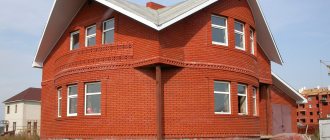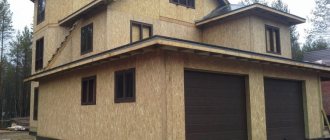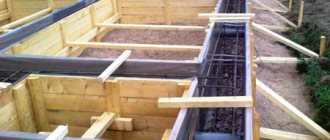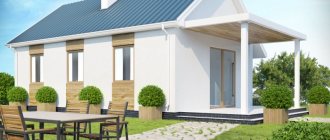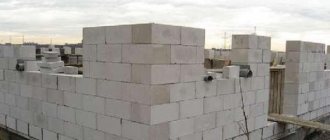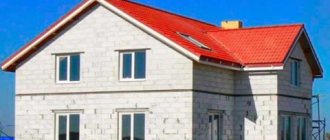Today, cellular concrete is used in various fields; up to 20% of new buildings are built from it. It is a suitable material for residential structures intended for temporary or permanent residence.
Cellular concrete has an affordable price and good performance characteristics.
Foundation for a house made of foam blocks
Foam concrete weighs little, so it is easy to work with. The foundation for the building requires a small load-bearing capacity.
Such a foundation is inexpensive. However, on moving soil, the weight of the base is not enough to suppress heaving processes. High demands are placed on the construction of aerated concrete foundations.
Incorrect calculations will lead to the fact that the foundation will have to be repaired or rebuilt again. Savings on a project usually result in additional expenses.
What is good about a house made of aerated concrete blocks?
While remaining “non-flammable,” this porous building stone allows air to pass almost as well as wood and is highly durable. Manufacturing a block from aerated concrete is possible only in factory conditions. It has many advantages.
- Low cost, additional savings on transportation (light), rental of heavy special equipment.
- Precise geometry , which allows you to lay blocks with minimal gaps and increase resistance to cracking.
- Ease of processing reduces construction time. Aerated concrete is sawed, drilled, and grooved using simple tools.
- Good thermal insulation - the material is 2-3 times warmer than usual, which allows you to save on heating.
- "Breathability" However, hygroscopicity is undesirable in a humid climate and is protected from it by the brick cladding of an aerated concrete cottage.
The company's architects help you select a standard residential building project that best meets the requirements in terms of price, size, and style.
Choosing a foundation type
What kind of foundations are built for aerated concrete houses? It is necessary to analyze the condition of the soil; for an area where there is no heaving, a monolithic belt type is built.
It is important that the base goes down to a depth below the freezing mark of the soil. With the help of tape reinforcement, heaving loads are compensated.
In some regions, the soil freezes to a depth of less than 2 m. It is not economically feasible to erect a strip foundation. Instead, a pile-grillage foundation is made. The grillage allows you to compensate for movements - the rise of one pile is higher than the others. If you do not install a grillage, cracks will inevitably appear in the walls.
The most expensive and durable foundation is considered to be a monolithic slab. This is a suitable option for peat bogs and loose sand. The slab is preferred when it is impossible to install piles. Prefabricated foundations are not recommended.
A professional designer can determine exactly what materials are suitable for constructing a foundation for aerated concrete construction on a specific site. To do this, he will need the results of geological research.
Design documentation for a house made of aerated concrete
On the website, the future owner of the cottage can examine it from all sides, change materials, color, and calculate an estimate for construction. By making an informed choice, as a result, he will receive exactly the kind of modern country house he dreamed of. When viewing any finished project with a layout and photo from the catalog, you will notice several important details.
- Detailed study - the documentation package includes detailed drawings: the area and dimensions of each room are given.
- Selection of building materials - they are indicated for each type of structure: foundation, floor, walls and roof (reinforced concrete slab, block, wooden logs).
- Exterior finishing - the project documentation lists various possible options (decorative stone, brick, plaster).
Professionally executed solutions allow you to build a house from aerated concrete in a technologically correct manner, with a guarantee of durability.
Is a plinth needed?
The building material is characterized by high hygroscopicity. High humidity negatively affects the heat-insulating properties; when left in water for a long time, the material is destroyed.
An aerated concrete house requires a base and good waterproofing. During construction, the groundwater level and geological research data are taken into account.
Features of houses made of gas silicate blocks
The main feature of such a block is its low weight and fairly large dimensions. This greatly speeds up the laying of the house. The speed of building a house is also increased thanks to the use of special glue rather than solutions. Also, such a block has good heat and sound insulation, which is ensured by the presence of air bubbles inside it. Houses using them are more heat efficient. Another advantage is the low cost of gas silicate blocks compared to other materials for masonry walls.
Photo: version of a gas silicate house with brick exterior
Photo: laying gas silicate blocks
Laying aerated concrete material
The preparatory stage is represented by the following steps:
- Checking the horizontalness of the base. Deviations up to 30 mm are allowed.
- Cut-off waterproofing device. A layer of bitumen mastic is applied, and waterproofing is applied on top, using roll material. You should not choose cheap roofing material, which quickly becomes unusable.
- A level base is a prerequisite for simple masonry.
How to lay aerated concrete blocks?
The laying of aerated concrete blocks is carried out in the same way as brick. It is necessary to do horizontal tying of rows. The wall looks more aesthetically pleasing when the vertical seam falls in the middle of the aerated block; it is necessary that the indentation be at least 10 cm.
A special adhesive is applied to the blocks using a carriage equipped with teeth along the edge. To ensure a good fit of individual blocks and minimize heat loss, an adhesive thickness of no more than 1 - 2 mm is needed.
Pros and cons of blocks
The advantages are the following:
- Light weight - you can load/unload aerated concrete products, as well as build a house from them, alone;
- Excellent sound insulation - the presence of many voids guarantees excellent insulation of all street noise;
- Ease of processing - to cut a block of aerated concrete when building a cottage yourself, a hacksaw is enough;
- Low thermal conductivity - a house made of gas silicate is warm and energy efficient;
- High speed of wall construction - the blocks are larger in size than standard 1NF bricks, which greatly speeds up the masonry process;
- Non-flammability – gas silicate belongs to the group of low-flammable materials “G1”.
Construction of block walls
Houses made from gas silicate blocks are famous for their comfort and environmental friendliness. Thanks to good vapor permeability, their walls are “breathable”. However, such a cottage can be built with a maximum of two floors. Otherwise, if the load is too heavy, the lower rows will begin to collapse under the weight of those laid on top.
Gas silicate blocks also have disadvantages, including
- High water absorption;
- Relatively low heat resistance.
Aerated concrete does not burn. However, at temperatures above 700 C it begins to collapse. After a severe fire, a house made of gas silicate blocks will most likely become unsuitable not only for habitation, but also for reconstruction.
The second problem is moisture absorption. When water gets on aerated concrete, almost all of it ends up inside the block. And when it freezes, such a “sponge” simply breaks into pieces.
In this regard, ceramic blocks have much more advantages. Of course, photos of brick houses sometimes disappoint aesthetes with efflorescence stains, which are also associated with exposure to moisture. But this does not have much effect on the strength of the masonry. But gas silicate blocks, when exposed to water, quickly begin to lose their high thermal characteristics and gradually deteriorate.
This is what a damp block looks like
Why is aerated concrete reinforced?
On heaving soils, reinforcement is required to increase the resistance of the building. The reinforcement is placed in grooves in the middle of the blocks. The overlap of the rods is 10 - 20 cm. The rods are bent in the openings.
Above the window and door assemblies, 4-bar elements are used. They are placed in special U-shaped gas blocks.
The finished elements are filled with M-200 concrete mortar.
Six advantages of aerated concrete buildings
- The house does not need to be additionally insulated, since the air contained in the material is itself an excellent insulator.
- It is possible to build buildings in cold areas, as they will be frost-resistant.
- Guaranteed against fire, as aerated concrete does not burn and is not toxic.
- A strong foundation is not required, since the material is quite light.
- For the same reason, during construction there will be no need for equipment that lifts large loads.
- It is possible to create walls of any configuration, the material is easy to cut and arches or bay windows are quite simple to make.
One way to reduce the hygroscopicity of aerated concrete walls is to treat them with a special agent that repels moisture. If you do this twice a year, you can prevent the occurrence of any deformities.
What to pay attention to when reinforcing window openings?
When the window opening exceeds 1.8 m, the penultimate row of masonry is reinforced. Make 2 grooves 50 cm longer than the openings. Subsequently, the grooves are filled with adhesive or cement mortar.
Is it possible to spend the winter without heating? Sometimes it is not possible to complete construction work completely within a season. The box is left for the winter without connecting the heating system. The following measures will help prevent the appearance of cracks on the walls in the spring:
- If groundwater is close, drainage is needed.
- It is necessary to carry out waterproofing and insulate the foundation and plinth.
- Insulate the blind area around the structure.
- Insulate floors in the basement.
Thanks to the above measures, freezing of the soil under the foundation can be avoided. It is recommended to additionally maintain the temperature in the basement above zero.
Advantages of houses made of gas silicate
Gas silicate is a block-type material made on the basis of cellular concrete.
The material contains sand, water, aluminum powder and lime. When mixing the ingredients, the mass is foamed, shaped and set to harden. The blocks are characterized by low weight and ideal geometry, making laying quick and easy. Houses made of gas silicate have a number of advantages:
- light weight, so there is no need for a massive foundation;
- good thermal insulation and sound insulation characteristics;
- affordable cost of material;
- a wide range of ready-made standard projects;
- high strength;
- vapor permeability;
- fire, biostability and fire safety.
Masonry in gas silicate houses is carried out using a special adhesive composition. And due to the fact that the pores in the material are not isolated, it is important to protect the material from moisture absorption - for example, by plastering the surface both outside and inside.
The material allows the construction of low-rise buildings of any architectural form, using any finishing materials.
Photos of aerated concrete houses
leave a comment
Click to cancel reply.
You must log in to post a comment.
Houses made of foam blocks
- home
- Gallery
- Houses made of gas silicate block
You have decided to build a warm and reliable house from a gas silicate block. But we haven’t decided which manufacturer to choose yet. And so let’s begin a brief review of houses built from gas silicate blocks produced by KSM Stary Oskol. The house with an attic was built from gas silicate blocks from the Universal line produced by Starooskolsky KSM. Looking ahead a little, we will say that the wall block of the Starooskolsky plant is used not only for the construction of private houses, but also in the construction of multi-story shopping and business centers. By choosing Stary Oskol gas silicate for your construction, you get a high-quality and inexpensive foam block from the largest manufacturer in Russia
The Stary Oskol plant has launched the production of gas silicate blocks from the German Wehrhahn line (Wehrhahn) category 1 with ideal geometry for laying on glue. The construction of three-story houses from gas silicate grade D-600 is allowed. So, when purchasing Stary Oskol blocks for construction, you get high strength of the material, which not every manufacturer can boast of
The Stary Oskol gas silicate block from the Wehrhahn line has a very precise geometry and is suitable for laying with glue. The cold will not be able to penetrate into the room through a thin layer of glue and will quickly dissipate inside the foam block, which has a high degree of energy efficiency. Thanks to a thin seam, 2 mm thick. the walls of a house made of gas silicate block will better retain the warmth of your home
By using Stary Oskol gas silicate blocks for construction, you can implement any architectural design; they are ideal for building walls of any shape, even the most bizarre. The ease of cutting, installation and any other processing of the gas silicate block will give ample scope for realizing the most daring design ideas when building your home
The Stary Oskol plant produces a truly durable gas silicate block. The strength of the material is important not only when building multi-storey buildings and installing a suspended ventilated facade, but also when carrying out further internal work, for example, you will need to hang heavy furniture cabinets on walls made of gas silicate, and the fragility of Aerobel blocks does not allow this
The gas silicate block produced by KSM Stary Oskol brand D-500 is more thermally efficient than the D-600 block and is more suitable for building a house whose façade will be faced with ceramic facing bricks. The D-500 block is quite suitable for the construction of a two-story cottage, as it is structural and thermal insulating
Gas silicate blocks produced in Stary Oskol can be used for load-bearing structures of residential buildings up to three floors high. Depending on the climatic zone of construction, such buildings are either not insulated at all, or are additionally insulated with any type of thermal insulation. Due to its high characteristics and reasonable cost, the Stary Oskol block is used in the construction of high-rise frame residential buildings, as well as modern shopping and entertainment complexes and business centers in Moscow and other large cities. So, when choosing a high-quality gas silicate block for your construction, you should have no doubts, because the largest developers choose us
And in conclusion, we present to you a modern multi-storey residential complex built from a gas silicate block produced by the Stary Oskol building materials plant and facing ceramic bricks produced by OSMiBT Stary Oskol. Have you decided to build a cozy cottage from a gas silicate block? Or are you a representative of a construction company looking for high-quality building materials at reasonable prices? I think you should have no doubts when choosing a manufacturer of a gas silicate block. You can place an order in the official online store of the Stary Oskol plant

